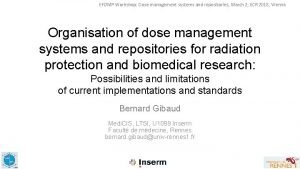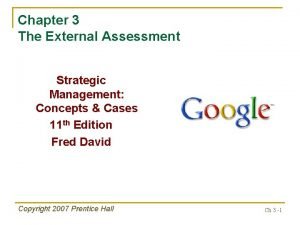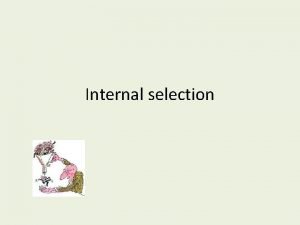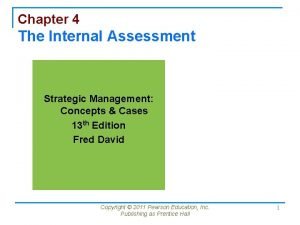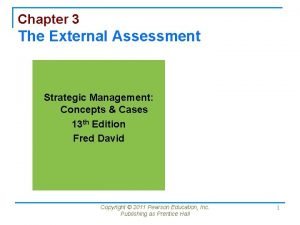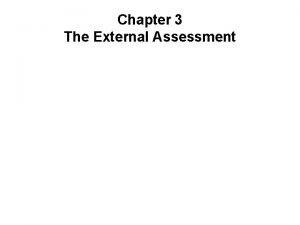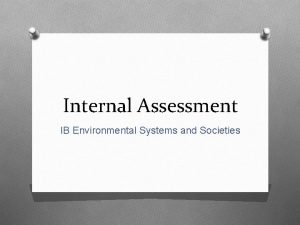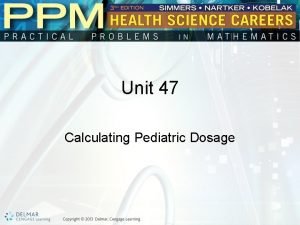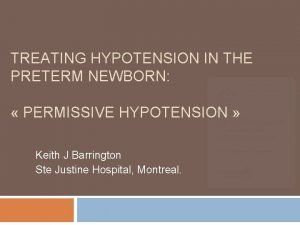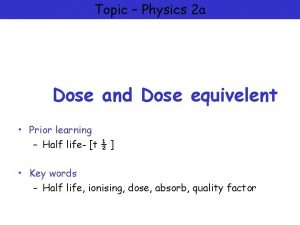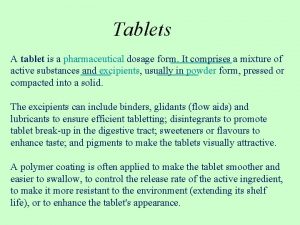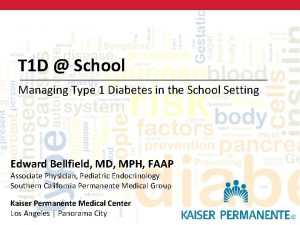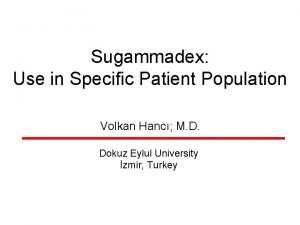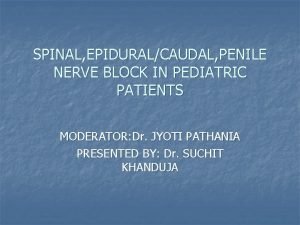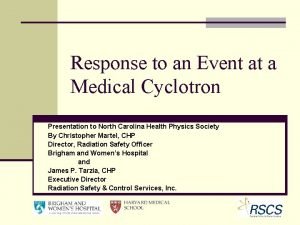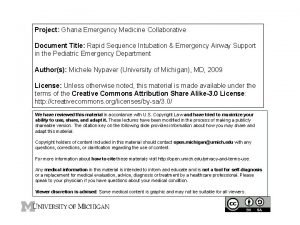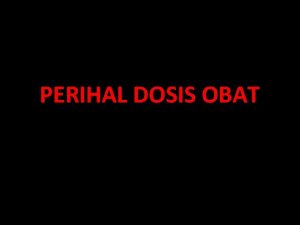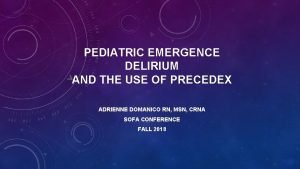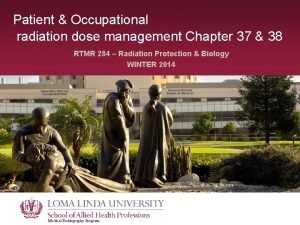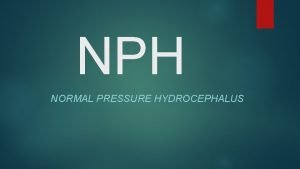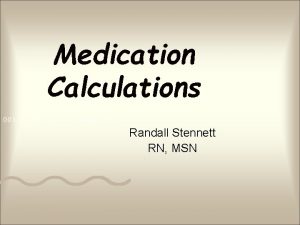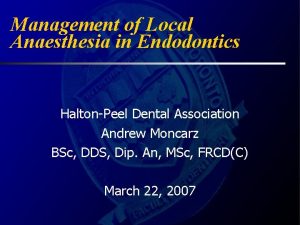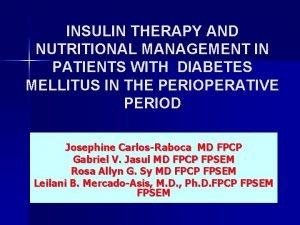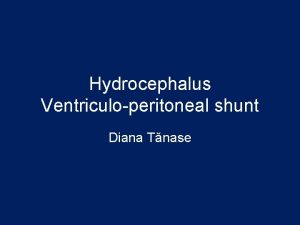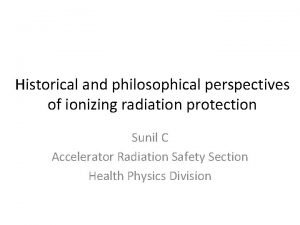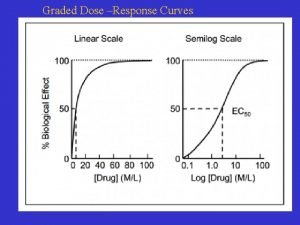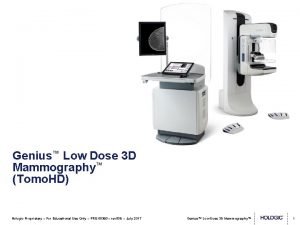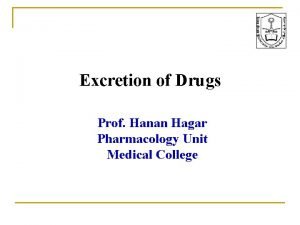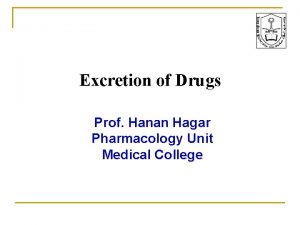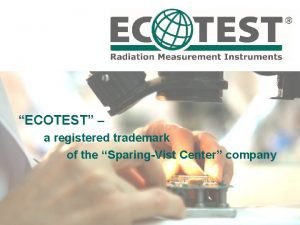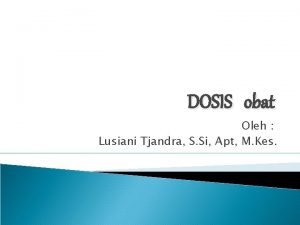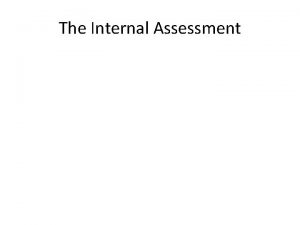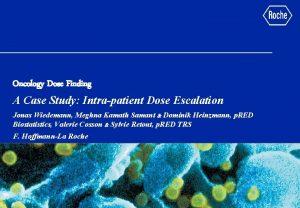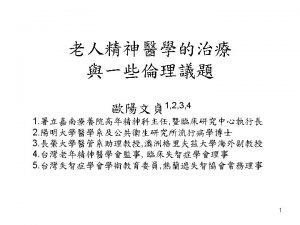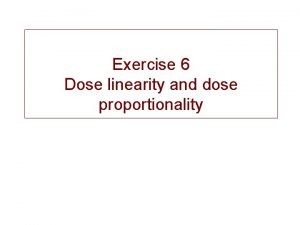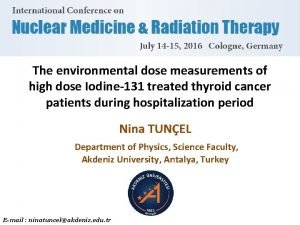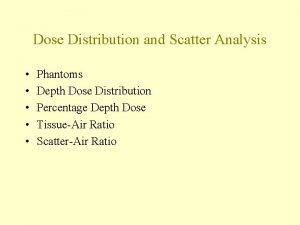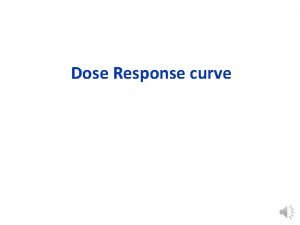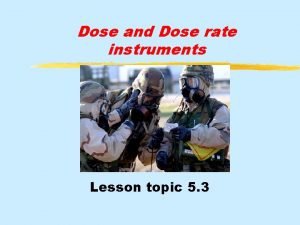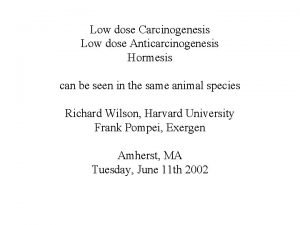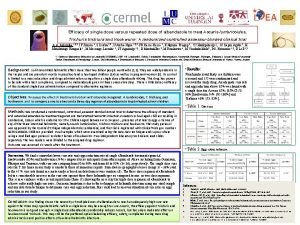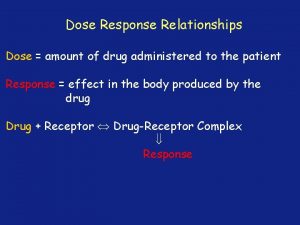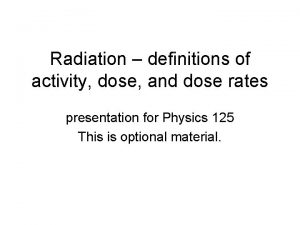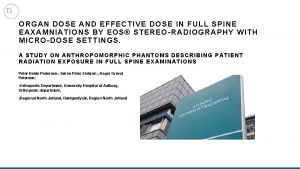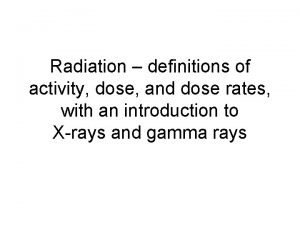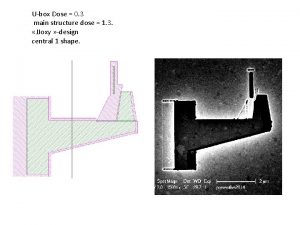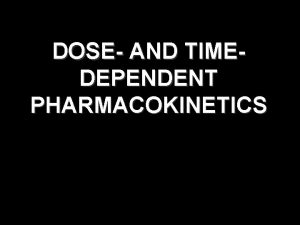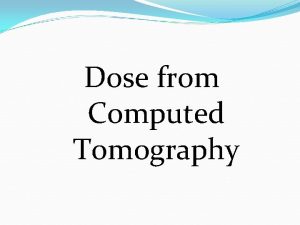Internal dose assessment Hans Richard Doerfel IDEA System




























































































- Slides: 92

Internal dose assessment Hans Richard Doerfel IDEA System Gmb. H, Karlsruhe, Germany IMBA Workshop Stockholm - 18 May 2015 1

Overview Assessment of internal doses can be divided into two phases, namely Determination of the amount of radioactive material in the human body, in body organs or in wounds by direct measurements and/or by indirect methods such as excretion analysis or air monitoring Interpretation of the monitoring data in terms of intake and/or internal dose taking into account many influencing factors and assumptions, such as the physical and chemical characteristics of the radioactive substances, the mode of intake, the biokinetic and energy absorption processes, the individual parameters, etc. IMBA Workshop Stockholm - 18 May 2015 2

Overview of the state of the art for both phases of the determination of internal dose Measuring techniques for individual incorporation monitoring: direct measurement of activity in the whole body or organs, and measurement of activity excreted with urine and faeces Biokinetic models used for the interpretation of the monitoring data, especially new ICRP model for the human alimentary tract and the NCRP model for the biokinetics of in wounds Application of the models for the assessment of committed dose: IDEAS General Guidelines, follow-up projects of EURADOS such as the CONRAD project or the upcoming TECHREC project IMBA Workshop Stockholm - 18 May 2015 3

Overview Measuring techniques IMBA Workshop Stockholm - 18 May 2015 4

Measuring techniques General The choice of measurement technique will be determined by a number of factors including the radiation emitted by the radionuclide the likely radiation dose the biokinetic behaviour of the contaminant and the availability of equipment. IMBA Workshop Stockholm - 18 May 2015 5

Measuring techniques General Routine monitoring programmes usually involve only one type of measurement if adequate sensitivity can be achieved. If different methods of adequate sensitivity are available, the general order of preference in terms of accuracy of interpretation is: body activity measurements excreta analysis personal air sampling and/or workplace monitoring Special monitoring in relation to a particular task or event may often involve a combination of techniques. IMBA Workshop Stockholm - 18 May 2015 6

Measuring techniques In vivo measurements Many publications giving guidance on in vivo measurement, such as International Commission on Radiation Units and Measurements, ICRU Report 69, Direct Determination of the Body Content of Radionuclides, Journal of the ICRU, Vol. 3, No 1 (2003) Landolt-Börnstein/New Series Group VIII: Advanced Materials and Technologies, Vol. 4 Radiological Protection, A. Kaul, D. Becker eds. , ISBN 3 -540 -20207 -2, Springer Berlin Heidelberg New York, 2005 IMBA Workshop Stockholm - 18 May 2015 7

Measuring techniques In vivo measurements Facilities for in vivo measurement of radionuclides consist of one or a number of high efficiency detectors in well-shielded, low-background environments. The geometrical configuration of the detectors corresponds to the purpose of the measurement, i. e. determination of whole-body activity Stretcher type whole body counter with 4 Na. I(Tl) scintillation detectors (Bicron 20 cm diam. × 10 mm crystals) for in vivo measurement of medium energy photon emitters (100 - 3000 ke. V) IMBA Workshop 8 Stockholm - 18 May 2015

Measuring techniques In vivo measurements Facilities for in vivo measurement of radionuclides consist of one or a number of high efficiency detectors in well-shielded, low-background environments. The geometrical configuration of the detectors corresponds to the purpose of the measurement, i. e. determination of whole-body activity or of activity in a region of the body such as the thorax Typical arrangement of 2 phoswich detectors (20 cm diam. 1 mm Na. I(Tl) / 50 mm Cs. I(Tl) crystals) for in vivo measurement of low energy photon emitters such as 210 Pb, 241 Am and isotopes of Pu in the lungs IMBA Workshop 9 Stockholm - 18 May 2015

Measuring techniques In vivo measurements Facilities for in vivo measurement of radionuclides consist of one or a number of high efficiency detectors in well-shielded, low-background environments. The geometrical configuration of the detectors corresponds to the purpose of the measurement, i. e. determination of whole-body activity or of activity in a region of the body such as the thorax Typical arrangement of 4 HPGe semiconductor detectors (Silena HPGe sandwich with 20 cm diam. planar p-type HPGe crystal backed by 50 % coaxial n-type HPGe crystal) for in vivo measurement of low energy photon IMBA Workshop 10 emitters such as 210 Pb, 241 Am and isotopes of Pu in the lungs Stockholm - 18 May 2015

Measuring techniques In vivo measurements Facilities for in vivo measurement of radionuclides consist of one or a number of high efficiency detectors in well-shielded, low-background environments. The geometrical configuration of the detectors corresponds to the purpose of the measurement, i. e. determination of whole-body activity or of activity in a region of the body such as the thorax or the skull. Typical arrangement of 4 HPGe for in vivo measurement of low energy photon emitters such as 210 Pb, 241 Am and isotopes of Pu in the skull IMBA Workshop Stockholm - 18 May 2015 11

In vivo measurements Detectors Up to the mid-1990 s most facilities used Na. I(Tl) scintillation detectors Large volume, high detection efficiency Poor energy resolution, interpretation of spectra obtained from a mixture of radionuclides is difficult, multiple linear regression analysis technique is required IMBA Workshop Stockholm - 18 May 2015 12

In vivo measurements Detectors Up to the mid-1990 s most facilities used Na. I(Tl) scintillation detectors Large volume, high detection efficiency Poor energy resolution, interpretation of spectra obtained from a mixture of radionuclides is difficult, multiple linear regression analysis technique is required Since the mid-1990 s many facilities use HPGe semiconductor detectors High energy resolution, interpretation of spectra obtained from complex mixtures of radionuclides is easy, although calibration is still needed) Small volume, small detection efficiency Recent developments to improve capabilities: Optimisation of the area and thickness of detectors, particular emphasis on the use of large detector arrays Room temperature semiconductor arrays utilising Si or Cd. Zn. Te IMBA Workshop Stockholm - 18 May 2015 13

In vivo measurements Activity calibration Almost all laboratories continue to use physical phantoms such as the Bottle-Mannikin-ABsorption (BOMAB) IMBA Workshop Stockholm - 18 May 2015 14

In vivo measurements Activity calibration Almost all laboratories continue to use physical phantoms such as the Bottle-Mannikin-ABsorption (BOMAB) or Lawrence Livermore thorax phantom IMBA Workshop Stockholm - 18 May 2015 15

In vivo measurements Activity calibration Almost all laboratories continue to use physical phantoms such as the Bottle-Mannikin-ABsorption (BOMAB) or Lawrence Livermore thorax phantom but this approach has significant limitations with respect to body size, body shape, and radionuclide distribution These limitations could in principle be overcome using numerical calibration techniques Voxel phantoms are constructed for real subjects using data from computed tomography (CT) or magnetic resonance imaging (MRI) scans. Monte-Carlo simulations are then used to model photon transport from the phantom to a simulated detector. IMBA Workshop Stockholm - 18 May 2015 16

In vivo measurements Detection characteristics Typical detection characteristics of a standard whole body counter for homogeneous depositions in the whole body (subject counting time 300 s; IMBA Workshop 17 background counting time 1800 s) Stockholm - 18 May 2015

In vivo measurements Detection characteristics Typical detection characteristics of a lung counter (4 HPGe detectors) for homogeneous depositions of some selected actinides in the lungs; subject counting time 3000 s; background counting time 30000 s) IMBA Workshop Stockholm - 18 May 2015 18

Measuring techniques In vitro measurements usually involve analysis of urine, analysis of faeces, if the material is relatively insoluble Other samples may be analysed for specific investigations, such as nose blow or nasal smears as routine screening techniques. blood samples in the case of suspected high level contamination (although difficult to relate to body content or intakes) IMBA Workshop Stockholm - 18 May 2015 19

Measuring techniques In vitro measurements The collection of urine samples involves three considerations: (1) (2) (3) care must be taken to avoid adventitious contamination of the sample it is usually necessary to assess the total activity excreted per unit time (typically 24 h) the volume required for analysis depends upon the sensitivity of the analytical technique The collection of faecal samples involves additional considerations: (4) (5) (6) because of the daily fluctuations in faecal excretion, collection should be over a period of several days (typically 3 days) faecal samples may be useful for the assessment of intake from the early lung clearance early results may be also useful in identifying exposed individuals after incidents IMBA Workshop Stockholm - 18 May 2015 20

In vitro measurements Detection characteristics Inductively coupled plasma-mass spectrometry (ICP-MS) Intruduction of the sample into a mass spectrometer by means of a Fluorimetry is a simple and fast technique for the determination of uranium in nebuliser in a plasma torch urine. Uranium is determined by the fluorescence produced when exposed to Separation of the atoms in a magnetic field according to their masses ultraviolet light. The urine sample may directly be fused in a platinium dish and Beside acidifying the urine sample no other treatment is needed. measured with a fluorimeter. The limitation of this technique is its poor For Pu analysis radiochemical separation of Pu from the bulk of 238 U. sensitivity and the measurement of total uranium only, mainly 238 inorganic material and from U is needed Advantages of ICP-MS: Laser-induced fluorimetry needs some treatment of the urine like co. Very sensitive for radionuclides with very long half-life such as 235 U, precipitation and calcination, or wet ashing before measuring the uranium content 238 U and 232 Th. Capable of measuring 239 Pu and 240 Pu separately, which is not possible by α spectrometry Very fast (results within few minutes). Typical detection characteristics of a standard whole body counter for homogeneous depositions in the whole body (subject counting time 300 s; IMBA Workshop 21 background counting time 1800 s) Stockholm - 18 May 2015

In vitro measurements Neutron activation analysis (NAA) is sufficiently sensitive to detect the natural content of U and Th in urine and environmental samples. NAA technique have Detection characteristics been applied for the measurement of 232 Th (MDA 0. 1 m. Bq/l) 238 U (MDA 0. 0025 m. Bq/l) Delayed neutron activation analysis (DNAA) is based on the measurement of delayed neutrons from fission of 235 U after irradiation of the evaporated sample by thermal neutrons. DNAA can be used only for the measurement of 235 U in urine (screening method for U in urine) IMBA Workshop Stockholm - 18 May 2015 22

Overview Biokinetic models IMBA Workshop Stockholm - 18 May 2015 23

Biokinetic models Overview Knowledge of the behaviour of radioactive materials within the human body is essential for internal dose assessment. This part of the course gives a general description of the routes of intake of radionuclides into the body, subsequent transfers within and out of the body and an overview of the current ICRP biokinetic models used to calculate body or organ content and daily urinary or faecal excretion IMBA Workshop Stockholm - 18 May 2015 24

Biokinetic models Principal routes of intake: respiratory tract, Routes of intake gastrointestinal tract, intact skin, and wounds Distribution of systemic activity in the body can be diffuse and relatively homogeneous, e. g with tritiated water, or localised in certain organs or tissues, e. g. with iodine (thyroid), alkaline earth metals (bone), plutonium (bone and liver). Principal routes of removal: urinary excretion (systemic) faecal excretion (direct from GI tract and systemic) IMBA Workshop 25 Stockholm - 18 May 2015

Biokinetic models The Guide for the Practical Application of the HRTM (Bailey et al) provides extensive Human Respiratory Tract Model (HRTM) guidance on the application of the HRTM. In the model (ICRP Publication 66) the respiratory tract is represented by five regions: extrathoracic (ET) airways: ET 1 (anterior nasal passage) ET 2 (posterior nasal and oral passages, the pharynx and larynx) thoracic regions: BB (bronchial -trachea and bronchi), bb (bronchiolar) AI (alveolar-interstitial - gas exchange region) Lymphatic tissue associated with the extrathoracic and thoracic airways LNET and LNTH respectively IMBA Workshop Stockholm - 18 May 2015 26

Biokinetic models Deposition Human Respiratory Tract Model (HRTM) Reference subject: normal nose-breathing adult male at light work Default Activity Median Aerodynamic Diameter (AMAD): 5 μm (occupational exposure) Fractional deposition in each region of the respiratory tract of the reference worker: IMBA Workshop Stockholm - 18 May 2015 27

Biokinetic models Human Respiratory Tract Model (HRTM) Clearance Material deposited in ET 1 is removed by extrinsic means such as nose-blowing. In other regions clearance is competitive between the movement of particles towards the GI tract and lymph nodes and the absorption into blood of material from the respiratory tract and the lymph nodes Removal rates due to particle transport and absorption to blood are taken to be independent. IMBA Workshop Stockholm - 18 May 2015 28

Biokinetic models Human Respiratory Tract Model (HRTM) Particle transport (compartment model for insoluble particles) Rates shown alongside arrows are reference values in units of d– 1. (i) AI deposit is divided between AI 1, AI 2 and AI 3 in the ratio 0. 3: 0. 6: 0. 1; (ii) the fraction of the deposit in BB and bb that is cleared slowly (BB 2 and bb 2) is 50% for particles of physical size <2. 5 μm and decreases with diameter >2. 5 μm, and the fraction retained in the airway wall (BBseq and bbseq) is 0. 7% at all sizes IMBA Workshop 29 (iii) 0. 05% of material deposited in region ET 2 is retained in its wall (ETseq) and the rest in Stockholm - 18 May 2015 compartment which clears rapidly to the GI tract.

Biokinetic models Dissolution There are two equivalent systems: Human Respiratory Tract Model (HRTM) (a) The simplest compartment model representation of time-dependent dissolution is to assume that a fraction (fr) dissolves relatively rapidly, at a rate sr, and the remaining fraction (1 – fr) dissolves more slowly, at a rate ss. (b) In this, the material deposited in the respiratory tract is assigned to “Particles in initial state” in which it dissolves at a constant rate sp. Material is simultaneously transferred to “Particles in transformed state” in which it has a different dissolution rate, st. With this system, the initial dissolution rate is approximately sp and the final dissolution rate is approximately st. Thus with suitable choice of parameters, including st > sp, an increasing dissolution rate can be represented. IMBA Workshop 30 Stockholm - 18 May 2015

Type F: 100% absorbed with a half-time of 10 minutes. There is rapid absorption of almost all material deposited in BB, bb, and AI, and 50% of material deposited in ET 2. The other 50% of material deposited in ET 2 is cleared to the GI tract by particle transport. Biokinetic models Human Respiratory Tract Model (HRTM) Type M: 10% absorbed with a half-time of 10 minutes and 90% with a half-time of 140 d. There is rapid absorption of about 10% of the deposit in BB and bb; and 5% of material deposited in ET 2. About 70% of the deposit in AI eventually reaches body fluids. Type S: 0. 1% absorbed with a half-time of 10 minutes and 99. 9% with a half-time of 7000 d. There is little absorption from ET, BB, or bb, and about 10% of the deposit in AI eventually reaches body fluids. IMBA Workshop Stockholm - 18 May 2015 31

Biokinetic models Human Alimentary Tract Model (HATM) Recently the GI tract model of ICRP 30 has been replaced by the HAT Model described in ICRP Publication 100 Structure of HATM The dashed boxes are included to show connections between the HATM and the HRTM and systemic biokinetic models. f. A gives net transfer to blood and replaces the f 1 value of the gastrointestinal tract model. In general, uptake of radionuclides is assumed to occur from the small intestine. IMBA Workshop Stockholm - 18 May 2015 32

Biokinetic models Main features Human Alimentary Tract Model (HATM) Doses are calculated for the oral cavity, oesophagus, stomach, small intestine, right colon, left colon and rectosigmoid Colon doses are combined as a mass-weighted mean to include the right colon, left colon and rectosigmoid. Gender-dependent parameter values for adults for dimensions and transit times of contents through the regions (age-dependent parameter values are also specified for use in future calculations of doses to members of the public). IMBA Workshop Stockholm - 18 May 2015 33

Biokinetic models Absorption through intact skin Generally, radionuclides do not cross the intact skin to any significant extent. Exceptions of practical importance are tritium oxide as liquid or vapour, organic carbon compounds and iodine as vapour or in solution. There is no general model of entry of radionuclides through the skin because of the large variability of situations which may occur. Many factors must be taken into account in dose assessment such as the chemical form of the compound, the location and the surface of the contaminated area as well as the physiological state of the skin. For skin contamination, both the radiation dose to the area of contaminated skin and the dose to the whole body as a result of absorption need to be considered (more details in ICRP Publication 60). IMBA Workshop Stockholm - 18 May 2015 34

Biokinetic models NCRP wound model The NCRP, in collaboration with the ICRP, has developed a biokinetic and dosimetric model for exposure to radionuclides from contaminated wounds (largely using experimental animal data due to the lack of adequate human information). The model can be used to calculate radiation doses to the wound site, committed doses to organs and tissues and committed effective doses, as well as urinary and faecal excretion patterns for bioassay interpretation. IMBA Workshop Stockholm - 18 May 2015 35

Biokinetic models Four categories of retention were defined NCRP wound model for radionuclides present in a wound initially in soluble form weak, Five compartments were designated to moderate, describe certain physical or chemical strong and states of the radionuclide within the avid, which refer generally to the magnitude of wound site: persistent retention in the wound. Soluble (S); The criteria for categorization were Colloidal and Intermediate State (CIS), the amount retained 1 d after deposition and Particles; Aggregates and Bound State (PABS), the rate of clearance of the remainder. Trapped Particles and In addition three other categories of Aggregates (TPA), and deposit cover particles, Fragments. colloids and fragments. IMBA Workshop Stockholm - 18 May 2015 36

Biokinetic models NCRP wound model Release from the wound site occurs via blood for soluble materials and lymph nodes for particulates. Further solubilisation of particles in lymph nodes also provides for radionuclide to the blood. Once the radionuclide reaches the blood, it behaves biokinetically as if it had been injected directly into blood (same approach as is taken for the HRTM and HATM). IMBA Workshop Stockholm - 18 May 2015 37

Biokinetic models for systemic activity ICRP 30 reviewed information on the behaviour of radionuclides that had entered in the body. Biokinetic models have been developed for inhalation and ingestion, applying especially for workers not for the public More recently, ICRP revised the biokinetic models for selected radionuclides of 31 elements (Publications 56, 67, 69 and 71) and these have been applied in the calculation of dose coefficients for workers and for infants, children and adult members of the general population The models given in these Publications were primarily developed to provide age‑dependent dose coefficients, updated dose coefficients for workers (ICRP 68), and biokinetic functions for the interpretation of bioassay data (ICRP 78). IMBA Workshop Stockholm - 18 May 2015 38

Biokinetic models for systemic activity During the last 10 years the biokinetic models recommended for adults have been reviewed by ICRP and will be published very soon as ICRP PUBLICATION XXX - Occupational Intakes of Radionuclides Part 1: probably this year Part 2: probably next year Part 3: … A key feature of the updated models is that they will be applicable for both the calculation of doses (prospective) and the interpretation of bioassay data (retrospective). IMBA Workshop Stockholm - 18 May 2015 39

Biokinetic models for systemic activity Radionuclides entering the blood may distribute throughout the body (e. g. 3 H, 24 Na, 42 K, 137 Cs), selectively deposit in a particular tissue (e. g. 131 I in the thyroid; 90 Sr in bone) or deposit in significant quantities in a number of tissues (e. g. 239 Pu, 241 Am, 144 Ce). IMBA Workshop Stockholm - 18 May 2015 40

Overview Application of the biokinetic models for internal dose assessment IMBA Workshop Stockholm - 18 May 2015 41

Application of biokinetic models Understanding exposure situations Workplace information should be gathered in order to understand the exposure situation, e. g. radionuclides that may have been incorporated chemical form, presumed particle size (typically 1 or 5 m), likely time of intake, likely mode of intake (single, multiple or chronic, and likely pathway of intake. IMBA Workshop Stockholm - 18 May 2015 42

Application of biokinetic models Understanding exposure situations If no special information is available, the following default parameter values could be used (reference procedure): Mode of intake: Single intake Time of intake: Mid-point of the monitoring interval, i. e. the mid-point of the time range between the date of the measurement being considered and the date of either the previous measurement or the beginning of monitoring Inhalation: AT and f 1 value: Particle size: Ingestion: f 1 value: defaults according to ICRP publications. 5 m AMAD default according to ICRP. IMBA Workshop Stockholm - 18 May 2015 43

Application of biokinetic models Understanding exposure situations: Time of intake A principal source of uncertainty in the interpretation of bioassay data is the determination of the time of intake. In general, the time will not be known beforehand, especially in the case of routine monitoring. If a significant intake and effective dose is calculated, using the reference procedure, then a more realistic determination may be required. If several bioassay results are available, perhaps including different types of measurement, a comparison of these results with the respective biokinetic functions may help to assess the most likely time of intake. IMBA Workshop Stockholm - 18 May 2015 44

Application of biokinetic models Understanding exposure situations: Time of intake Determination of the most likely time of intake by fitting the excretion function to data Assumed time of intake obviously too early IMBA Workshop Stockholm - 18 May 2015 45

Application of biokinetic models Understanding exposure situations: Pathway of intake Analyse of Pu excretion data assuming injection… Analyse of Pu excretion data assuming ingestion… Intakes by inhalation alone are the most frequent in the workplace. Analyse of Pu excretion data assuming inhalation… However, intakes by ingestion or uptake through wounds and intact skin cannot be excluded. Again, a comparison of the measured results with the biokinetic functions may help in determining the pathway of intake. IMBA Workshop Stockholm - 18 May 2015 46

Application of biokinetic models Understanding exposure situations: Absorption type Intakes by inhalation alone are the most frequent in the workplace. Analysis of Co data assuming absorption type S (SF = 2. 24) So a comparison of the measured results with the biokinetic functions may help in However, the absorption type is not always known. determining also the absorption type. Analysis of Co data assuming absorption type M (SF = 1. 9) IMBA Workshop Stockholm - 18 May 2015 47

Application of biokinetic models Understanding exposure situations: Absorption type Intakes by inhalation alone are the most frequent in the workplace. However, the absorption type is not always known. Analysis of Co data assuming a mixture of absorption types So a comparison of the measured results with the biokinetic functions may help in M and S (SF = 1. 56) determining also the absorption type. Analysis of Co data assuming absorption type S (SF = 2. 24) Analysis of Co data assuming absorption type M (SF = 1. 9) IMBA Workshop Stockholm - 18 May 2015 48

The IDEAS guidelines Background Why do we need such guidelines? Results of the last intercomparison exercises i. e. 3 rd European Intercomparison Exercise on Dose Assessment from Incorporation Monitoring Data (1998/1999) IMBA Workshop Stockholm - 18 May 2015 49

The IDEAS guidelines Background 3 rd European Intercomparison Exercise Case 7: Pu-239/240 29 answers 0. 0137. . 1800 m. Sv 0. 0137 m. Sv Don‘t worry! 1800 m. Sv You are above all limits! IMBA Workshop Stockholm - 18 May 2015 50

The IDEAS guidelines Background Results in terms of CED: GM (m. Sv) GSD Case 1: H-3 0. 005 1. 16 Case 2: Sr-90 0. 093 1. 78 Case 3: I-125 0. 441 1. 53 Case 4: Cs-137 0. 198 1. 15 Case 5: Po, U, Th 0. 355 2. 31 Case 6: Pu-239 240 2. 4 Case 7: Pu-239/240 347 2. 16 IMBA Workshop Stockholm - 18 May 2015 51

The IDEAS project: Cost-shared action in 5 th FP October 2001 – June 2005 The aim of the project: To develop guidelines to standardise assessments of internal doses IMBA Workshop Stockholm - 18 May 2015 52

Philosophy of the IDEAS guidelines General philosophy Harmonisation: by following the procedures any two assessors should obtain the same estimate of dose from a given data set Accuracy: the “best” estimate of dose should be obtained from the available data Proportionality: the effort applied to the evaluation should be proportionate to the dose – the lower the dose, the simpler the process should be. IMBA Workshop Stockholm - 18 May 2015 53

Philosophy of the IDEAS guidelines Levels of task Level 0: Annual dose < 0. 1 m. Sv No evaluation of dose needed. Level 1: Annual dose typically 0. 1 – 1 m. Sv Simple, “reference” evaluation, with ICRP defaults used for all parameter values, except where there is better a priori information available Level 2: Dose from the intake typically 1 – 6 m. Sv More sophisticated evaluation using additional information to give more realistic assessment of dose: Adjustment of AMAD, absorption type or the time of intake if unknown Level 3: Dose from the intake typically > 6 m. Sv Advanced evaluation, which applies to cases where there are comprehensive data available: Systematic adjustment of the model parameter values (“step-by-step” approach), until the goodness of fit is acceptable IMBA Workshop Stockholm - 18 May 2015 54

The IDEAS project Contents of the guidelines: Overview Detailed information about the data handling • handling of single data and multiple data sets, • handling of extended exposures • number and type of data required for the dose assessment • processing of data before use, • assessment of the uncertainty on data, • handling of data below the limits of detection, • handling of data influenced by chelation therapy • and the identification of rogue data General information about the evaluation of the monitoring data reflecting the general philosophy Structured approach of the dose assessment reflecting the levels of task. IMBA Workshop Stockholm - 18 May 2015 55

The IDEAS project Contents of the guidelines: Overview Detailed information about the data handling • handling of single data and multiple data sets, • handling of extended exposures • number and type of data required for the dose assessment • processing of data before use, • assessment of the uncertainty on data, • handling of data below the limits of detection, • handling of data influenced by chelation therapy • and the identification of rogue data General information about the evaluation of the monitoring data reflecting the general philosophy Structured approach of the dose assessment reflecting the levels of task. IMBA Workshop Stockholm - 18 May 2015 56

The IDEAS project Contents of the guidelines: Handling of monitoring data Processing of data before use Lung data Generally, the combined activity in lungs and thoracic lymph nodes is referred to as ‘lung’ activity. Where estimates of lung and lymph activity are given separately, they should be summed. “Chest” measurements may also include counts from activity in liver and skeleton for most of the actinides, and their contributions will be need to be subtracted. Faeces data The transit time through the GI tract is subject to large inter (and intra-) subject variations. Moreover, the GI tract is represented by a series of compartments that clear exponentially, in practice, the movement is more like “slug” flow. It is therefore unlikely that individual daily faecal clearance measurements in the first few days after intake will follow the predicted pattern, and so it is best to consider cumulative excretion over the first few days. Urine data If the data are given in terms of Bq/liters then this can be normalized to daily excretion rates by assuming 1. 6 liters of urine are excreted per day. IMBA Workshop Stockholm - 18 May 2015 57

The IDEAS project Contents of the guidelines: Handling of monitoring data Handling of single data and multiple data sets Single data IMBA Workshop Stockholm - 18 May 2015 58

The IDEAS project Contents of the guidelines: Handling of monitoring data Handling of single data and multiple data sets Single data Simple average IMBA Workshop Stockholm - 18 May 2015 59

The IDEAS project Contents of the guidelines: Handling of monitoring data Handling of single data and multiple data sets Single data Simple average Unweighted least-square fit IMBA Workshop Stockholm - 18 May 2015 60

The IDEAS project Contents of the guidelines: Handling of monitoring data Handling of single data and multiple data sets Single data Simple average Unweighted least-square fit Weighted least-square fit IMBA Workshop Stockholm - 18 May 2015 61

The IDEAS project Contents of the guidelines: Handling of monitoring data Handling of single data and multiple data sets Single data Simple average Unweighted least-square fit Weighted least-square fit Maximum likelihood method IMBA Workshop Stockholm - 18 May 2015 62

The IDEAS project Contents of the guidelines: Overview Detailed information about the data handling • handling of single data and multiple data sets, • handling of extended exposures • number and type of data required for the dose assessment • processing of data before use, • assessment of the uncertainty on data, • handling of data below the limits of detection, • handling of data influenced by chelation therapy • and the identification of rogue data General information about the evaluation of the monitoring data reflecting the general philosophy Structured approach of the dose assessment reflecting the levels of task. IMBA Workshop Stockholm - 18 May 2015 63

The IDEAS project Contents of the guidelines: Overview Detailed information about the data handling • handling of single data and multiple data sets, • handling of extended exposures • number and type of data required for the dose assessment • processing of data before use, • assessment of the uncertainty on data, • handling of data below the limits of detection, • handling of data influenced by chelation therapy • and the identification of rogue data The uncertainty on data is important for: • objective decision on significance of a measured value General information about the evaluation of the monitoring data reflecting the general • application of weighted fitting procedures philosophy • identification of rogue data • definition of “goodness-of-fit” criteria Structured approach of the dose assessment reflecting the levels of task. • application of statistics, such as the 2 IMBA Workshop Stockholm - 18 May 2015 64

The IDEAS project Contents of the guidelines Grouping of uncertainty Type A: Can be described by the Poisson distribution (i. e. counting errors) Type B: All others (i. e. uncertainty of calibration standards etc. ) Definition of the scattering factor SF Assumption: Distribution of primary measuring results can be approximated by log-normal distributions Definition: The scattering factor is the geometric standard deviation of the distribution IMBA Workshop Stockholm - 18 May 2015 65

General guidelines for the estimation of committed dose from incorporation monitoring data (Project IDEAS) Structured approach of the dose assessment Stage 1: Check of the need for evaluation IMBA Workshop Stockholm - 18 May 2015 66

General guidelines for the estimation of committed dose from incorporation monitoring data (Project IDEAS) Structured approach of the dose assessment “Critical” monitoring quantity for Level 1 Stage 1: Check of the need for evaluation with Mc(1) T m. R (50) “critical” monitoring quantity for Level 1 monitoring interval for the monitoring quantity considered corresponding retention or excretion function for the monitoring quantity at time t = T/2 (i. e. it is assumed that the intake occurs at the mid-point of the monitoring interval) effective dose coefficient IMBA Workshop Stockholm - 18 May 2015 67

General guidelines for the estimation of committed dose from incorporation monitoring data (Project IDEAS) Structured approach of the dose assessment Stage 1: Check of the need for evaluation IMBA Workshop Stockholm - 18 May 2015 68

General guidelines for the estimation of committed dose from incorporation monitoring data (Project IDEAS) Structured approach of the dose assessment Stage 1: Check of the need for evaluation Stage 2: Check of the significance of measurement and consistency with previous evaluations IMBA Workshop Stockholm - 18 May 2015 69

General guidelines for the estimation of committed dose from incorporation monitoring data (Project IDEAS) Structured approach of the dose assessment Stage 1: Check of the need for evaluation Stage 2: Check of the significance of measurement and consistency with previous evaluations Stage 3: Standard „reference“ evaluation procedure IMBA Workshop Stockholm - 18 May 2015 70

General guidelines for the estimation of committed dose from incorporation monitoring data (Project IDEAS) Structured approach of the dose assessment Stage 1: Check of the need for evaluation Stage 2: Check of the significance of measurement and consistency with previous evaluations Stage 3: Standard „reference“ evaluation procedure Stage 4: Special evaluation procedure: Identification of pathway of intake IMBA Workshop Stockholm - 18 May 2015 71

The IDEAS guidelines Structured approach of dose assessment Structured approach of the dose assessment Stage 5: Special evaluation procedure for inhalation cases In the first stage (5 A), a simple evaluation is carried out using parameter values chosen a priori: before the evaluation is In the third stage (5 C), an advanced evaluation is carried out. In the second stage (5 B), procedures are applied for varying carried out. The procedure to the “Standard It applies to cases where is very similar there are comprehensive data the two main factors related to the inhaled material: the procedure” (Stage 3). The main difference is that in a special available. The fundamental approach of this stage is that the AMAD absorption Type, also the time of intake, procedure there should be more than one measurement. model and parameter values are and adjusted systematically, in if a not known, using the measurement data (a posteriori). specific order, until the goodness of fit is acceptable (i. e. the fits obtained to all the data are not rejected by the specified criteria). IMBA Workshop Stockholm - 18 May 2015 72

The IDEAS guidelines Structured approach of dose assessment Structured approach of the dose assessment Stage 5: Special evaluation procedure for inhalation cases Stage 5 A: Initial special evaluation using a priori parameters IMBA Workshop Stockholm - 18 May 2015 73

The IDEAS guidelines Structured approach of dose assessment Structured approach of the dose assessment Stage 5: Special evaluation procedure for inhalation cases Stage 5 A: Initial special evaluation using a priori parameters Stage 5 B: Varying the a priori AMAD, absorption type and/or time of intake, if not known IMBA Workshop Stockholm - 18 May 2015 74

The IDEAS guidelines Structured approach of dose assessment Structured approach of the dose assessment Stage 5: Special evaluation procedure for inhalation cases Stage 5 A: Initial special evaluation using a priori parameters Stage 5 B: Varying the a priori AMAD, absorption type and/or time of intake, if not known Stage 5 C: Systematic adjustment of model parameters (HRTM, HAT) until goodness of fit is acceptable IMBA Workshop Stockholm - 18 May 2015 75

The IDEAS project Findings of the IDEAS/IAEA intercomparison exercise: Testing of the guidelines: Joint IDEAS/IAEA intercomparison exercise Positive influence of the IDEAS guidelines on the Results in terms of CED: GM (m. Sv) GSD harmonization of reported intakes and doses Case 1: H-3 1. 06 26 Lower occurance of outliers for those participants who applied the guidelines Case 2: Cs-137 1. 16 Geometric mean of GSD: 1. 47 0. 093 Accurate results for those participants who applied Case 3: Co-60 the guidelines properly 1. 4 5. 0 3 rd European Intercomparison Exercise: Case 4: I-131 1. 07 2. 6 However, Geometric mean of GSD: 1. 71 Case 5: U-234 There is still a need for adequate training, 2. 4 27 experience and quality control Case 6: Pu-239 1. 58 140 Such intercomparison exercises should be repeated 2. 1 Case 6: Am-241 on a regular basis 52 IMBA Workshop Stockholm - 18 May 2015 76

Dissemination of the IDEAS guidelines ISO International Standardization Organization (ISO). The disillusioning experience with the past intercomparison exercises was also recognised by ISO Because of the substantial differences between national regulations, concepts, and dose assessment procedures, ISO recently initiated projects to standardize the monitoring of workers, the requirements for measuring laboratories and the processes for the quantitative evaluation of monitoring data. The anticipated standards include the need for a monitoring programme and the design of a monitoring programme, i. e. the methods and intervals, decision levels and approaches for dose assessments. These approaches correspond widely to the IDEAS Guidelines, this being of great importance for the harmonisation of internal dosimetry worldwide. IMBA Workshop Stockholm - 18 May 2015 77

A Structured Approach for the Assessment of Internal Dose The IDEAS guidelines Implementation of the structured approach in new software IDEA-System A new computer based expert system for incorporation monitoring IMBA Workshop Stockholm - 18 May 2015 78

IDEA System software Example IMBA Workshop Stockholm - 18 May 2015 79

IDEA System software Example IMBA Workshop Stockholm - 18 May 2015 80

IDEA System software Example IMBA Workshop Stockholm - 18 May 2015 81

IDEA System software Example IMBA Workshop Stockholm - 18 May 2015 82

IDEA System software Example IMBA Workshop Stockholm - 18 May 2015 83

IDEA System software Example IMBA Workshop Stockholm - 18 May 2015 84

IDEA System software Example IMBA Workshop Stockholm - 18 May 2015 85

IDEA System software Example IMBA Workshop Stockholm - 18 May 2015 86

IDEA System software Example IMBA Workshop Stockholm - 18 May 2015 87

IDEA System software Example IMBA Workshop Stockholm - 18 May 2015 88

IDEA System software Example IMBA Workshop Stockholm - 18 May 2015 89

IDEA System software Example IMBA Workshop Stockholm - 18 May 2015 90

IDEA System software Example IMBA Workshop Stockholm - 18 May 2015 91

Thank you for your attention! IMBA Workshop Stockholm - 18 May 2015 92
 Richard iii pursuit of power
Richard iii pursuit of power Whats central idea mean
Whats central idea mean Exegetical idea vs homiletical idea
Exegetical idea vs homiletical idea Contoh controlling idea
Contoh controlling idea Difference between main idea and central idea
Difference between main idea and central idea Unrelated sentences in paragraphs
Unrelated sentences in paragraphs Main idea stated and implied
Main idea stated and implied Penanda wacana isi pertama
Penanda wacana isi pertama Dose management system
Dose management system Envelope method is used for which floor stock
Envelope method is used for which floor stock Charge floor stock drugs
Charge floor stock drugs Explain the concept of internal control
Explain the concept of internal control Features of vouching
Features of vouching Ess ia topics
Ess ia topics Ia timeline
Ia timeline Key internal forces
Key internal forces Chapter 4 the internal assessment (strategic management)
Chapter 4 the internal assessment (strategic management) External assessment in strategic management
External assessment in strategic management Internal selection methods
Internal selection methods Internal assessment in strategic management
Internal assessment in strategic management External strategic management audit
External strategic management audit Internal and external assessment in strategic management
Internal and external assessment in strategic management Internal and external assessment in strategic management
Internal and external assessment in strategic management Internal and external assessment in strategic management
Internal and external assessment in strategic management Internal and external assessment in strategic management
Internal and external assessment in strategic management External assessment in strategic management
External assessment in strategic management The external assessment of strategic management
The external assessment of strategic management Internal audit plan sample for banks
Internal audit plan sample for banks Math ia checklist
Math ia checklist Internal assessment
Internal assessment Ib ess ia criteria
Ib ess ia criteria Ib
Ib Internal assessment in strategic management
Internal assessment in strategic management Documentation portfolio example
Documentation portfolio example Static assessment vs dynamic assessment
Static assessment vs dynamic assessment Portfolio assessment matches assessment to teaching
Portfolio assessment matches assessment to teaching Pediatric dosage calculations
Pediatric dosage calculations Lamivudine renal dose
Lamivudine renal dose Dobutamine low dose
Dobutamine low dose Esquema insulina regular pediatria
Esquema insulina regular pediatria Cryoprecipitate dose
Cryoprecipitate dose Equivalent dose is measured in
Equivalent dose is measured in Tablet in tablet dosage form
Tablet in tablet dosage form Insulin correction dose table
Insulin correction dose table Dose sugammadex
Dose sugammadex Max dose marcaine
Max dose marcaine Sacral hiatus
Sacral hiatus Folic acid dose in pregnancy
Folic acid dose in pregnancy Dopamine calculation formula
Dopamine calculation formula Dose conversion factor
Dose conversion factor Preesrd
Preesrd Etomidate dose intubation
Etomidate dose intubation Nibbling of uncovered skin
Nibbling of uncovered skin Neostick dose
Neostick dose Push dose epi
Push dose epi Dope tube placement
Dope tube placement Katzung
Katzung Intubating dose succinylcholine
Intubating dose succinylcholine Rumus dosis obat
Rumus dosis obat Medtronic minimed 530g
Medtronic minimed 530g Precedex drip
Precedex drip Dose limits radiology
Dose limits radiology Acetazolamide dose in hydrocephalus
Acetazolamide dose in hydrocephalus Neuromuscular junction
Neuromuscular junction Neptune temperature
Neptune temperature Dopamine iv dose
Dopamine iv dose Bactrim pediatric dosing
Bactrim pediatric dosing Medium dose ics and laba
Medium dose ics and laba Lidocaine max dose
Lidocaine max dose Quinientos
Quinientos Sanjita das
Sanjita das Classification of local anesthetics
Classification of local anesthetics Dose journalière admissible
Dose journalière admissible Photoelectric and compton effect
Photoelectric and compton effect Insulin
Insulin Insulin 70/30 dosage calculation
Insulin 70/30 dosage calculation Maintenance dose slideshare
Maintenance dose slideshare Cryoprecipitate
Cryoprecipitate Ssri comparison chart
Ssri comparison chart Vp shunt pathway
Vp shunt pathway Radiation dose limits for workers and public pdf
Radiation dose limits for workers and public pdf Dose response curve potency
Dose response curve potency Tomo hd
Tomo hd Drug dose calculation formula for child
Drug dose calculation formula for child Loading dose units
Loading dose units Loading dose units
Loading dose units Emt 6 rights
Emt 6 rights Ecotest radiation measurement instruments
Ecotest radiation measurement instruments Mixtard insulin dose calculation
Mixtard insulin dose calculation Pediatric amoxicillin dosage chart
Pediatric amoxicillin dosage chart Drop factor formula
Drop factor formula Drug dose calculation formula
Drug dose calculation formula Arti sacch lactis q.s
Arti sacch lactis q.s








